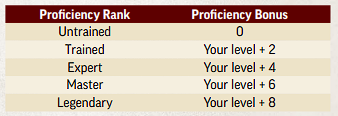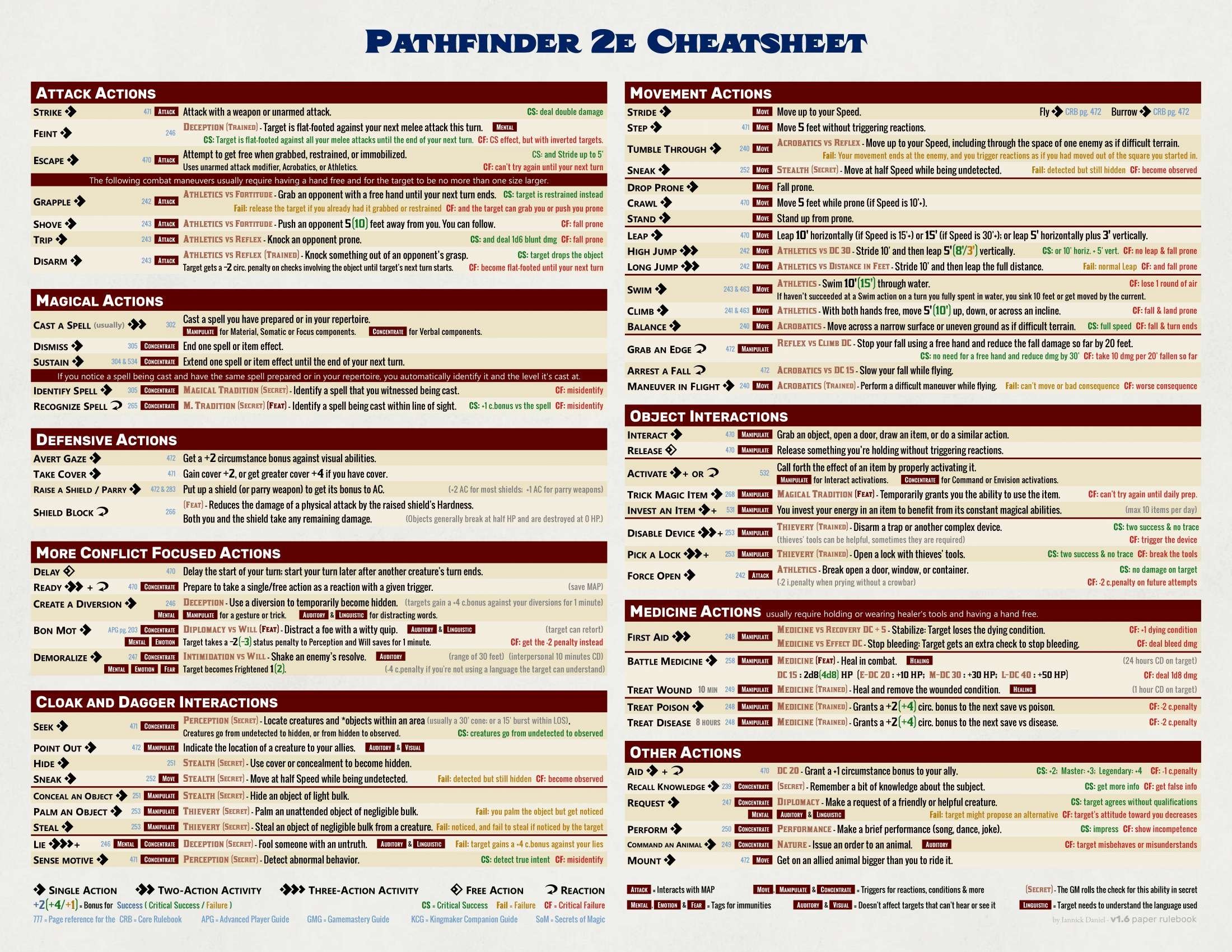Learning Pathfinder
A.How to do a d20 check
1. Roll a D20 and add an ability modifier and the proficiency bonus (if proficient)
Ability modifiers work like they do in D&D. Proficiency has ranks as follows:
Note that you add your level when you are trained in something… meaning as we level up, you will have trouble trying to do things you have not received training in.
2. Fortune and Misfortune Effects
This is like advantage and disadvantage in D&D but here are the specifics:
Fortune or misfortune abilities might allow you to reroll a failed roll, force you to reroll a successful roll, allow you to roll twice and use the higher result, or force you to roll twice and use the lower result. It’s specific to the ability and not just roll 2d20 and drop one.
You can never have more than one fortune and more than one misfortune effect come into play on a single roll. If multiple fortune effects would apply, you have to pick which to use. If two misfortune effects apply, the GM decides which is worse and applies it.
If both a fortune effect and a misfortune effect would apply to the same roll, the two cancel each other out, and you roll normally.
3. Add modifiers and subtract penalties
Bonuses will be one of: circumstance, status or item. If you have multiple item bonuses, for example, you only use the biggest one. Same for penalties, except that if a penalty is untyped, it can stack. This rule is essentially just the idea for handling duplicate effects.
4. Compare with the DC to get one of four possible results
Rolls equal to or higher than the DC are a success, and if 10 or more higher than the DC they are a critical success. Rolls lower than the DC are a failure, and 10 or more less than the DC they are a critical failure. Almost all effects can have a significant effect with a critical failure or success so every bonus +1 is important for avoiding critical failure or increasing the chance of a critical success.
5. Common kinds of check and DC
Attack rolls and the multiple attack penalty
Most melee attack rolls use Strength. Ranged weapons use Dexterity. “Finesse” tagged melee weapons allow either Strength of Dexterity to be used.
Using multiple actions with the “Attack” tag in a turn results in an increasing penalty of -5 for the second attack (-4 if the weapon has the “agile” tag) and -10 for any further attacks (-8 for weapons with “agile”). The multiple attack penalty only applies on your turn, and is not used for an attack of opportunity or commander’s strike, etc.
Ranged weapons have a range increment. When inside of the increment, no penalty is applied but for each multiple of the increment exceeded, a -1 penalty applies up to -5.Armor class
Armor Class = 10 + Dexterity modifier (up to your armor’s Dex Cap) + proficiency bonus + armor’s item bonus to AC + other bonuses + penalties
Note that it includes proficiency, and thus the character level, as well as training for the category (heavy, medium, light, etc.) of the armor.Spell attacks and saving throws
Spell attack roll result = d20 roll + ability modifier used for spellcasting + proficiency bonus + other bonuses + penalties
Spell DC = 10 + ability modifier used for spellcasting + proficiency bonus + other bonuses + penalties
These are basically the same as D&D, but proficiency includes the level. Rather than a saving throw for each attribute, Pathfinder only uses 3 saving throws:
Fortitude save result = d20 roll + Constitution modifier + proficiency bonus + other bonuses + penalties
Reflex save result = d20 roll + Dexterity modifier + proficiency bonus + other bonuses + penalties
Will save result = d20 roll + Wisdom modifier + proficiency bonus + other bonuses + penaltiesPerception and initiative
Perception check result = d20 roll + Wisdom modifier + proficiency bonus + other bonuses + penalties
Perception is generally used for initiative. Sometimes, it may be possible to use stealth or other skill checks.Other skill checks
Skill check result = d20 roll + modifier of the skill’s key ability score + proficiency bonus + other bonuses + penalties
Note the proficiency bonus includes your level! As you level up you will be almost certainly unable to even attempt a skill that you don’t have any training in.Behind the screen…. the GM is given these charts of DCs, repeated here for your consideration….
B. A few mORE GOTCHAS
Move in combat!
Most things don’t have an attack of opportunity.Hero points instead of inspiration
Each session you start with a hero point. You can gain them through good role playing also. You can have up to three points at a time. You can spend one hero point to reroll (even damage), or spend all your points to recover from dying.Resting and focus spells
The equivalent to a “long rest” is just “resting” for 8 hours per 24 hours, resetting spell caster slots, restoring fatigued, drained and doom conditions and restoring Constitution modifier * level HP (minimum 1). The equivalent of a short rest is refocusing, which takes 10 minutes and restores one focus point, if any.
Focus spells use focus points to activate class specific features, similar to D&D lay on hands, turn undead, monk ki points, sorcery points, warlock spell slots, etc. Most classes/archetypes can gain some kind of feature that uses focus points to give them a “per-combat” feature.Dying works differently…
The main thing to know is that if you recover from dying, you get a wounded stat that makes you start with more failed death saving throws the next time you drop to dying. For details see “Hit Points, Healing, and Dying”.Critical damage is double everything (dice AND modifiers)
Ranged thrown damage uses Strength. Bows and other ranged weapons, spells and consumable items like alchemical bombs do not add an attribute score to the damage. Melee characters are in more danger than ranged characters and this is one way Pathfinder seeks to balance different classes.
You take a –2 circumstance penalty to the attack roll when you make a nonlethal attack using a weapon that doesn’t have the nonlethal trait. You also take this penalty when making a lethal attack using a nonlethal weapon.
Persistent damage is a condition that causes damage to recur beyond the original effect. Unlike with normal damage, when you are subject to persistent damage, you don’t take it right away. Instead, you take the specified damage at the end of your turns, after which you attempt a DC 15 flat check to see if you recover from the persistent damage.
Shields have a few more steps to use them than in D&D
To activate the shield’s armor class bonus you need to take one action to “raise shield” each turn. Classes and characters that have extra shield skills can then also use a reaction when hit to have the shield absorb some of the damage. When shields absorb damage they can break and become useless. Characters can learn skills that allow them to repair damaged equipment.Instead of gaining a move, bonus action and action on your turn, Pathfinder uses a three action economy… see the explanation below for making the best of the three action economy.
There are a lot of conditions! Don’t worry about learning them all at the beginning, you can learn them a little at a time. See the explanation below. If you are a sneaky character that wants to hide, you should probably just read the rules about “Detecting Creatures”,
No multiclassing. Instead at level two and later, when you gain a class feat you can choose to take an archetype. There are more archetypes than classes and these grant a huge amount of customizability to your character.
Instead of attunement, characters “invest” an item. A character can have a maximum of 10 invested items per day. Investing takes one or more Interact actions. You can swap out items but items you no longer invest still count against the total invested items per day count even after it loses its investure.
Distances are counted with an extra 5 feet for every second diagonal. This means that effect areas are not squared circles….
c. Picking a class
Note the video below was made before the release of kineticist, exemplar and animist, but has very good basic description of each other class.
D. So You Want to Play a caster …
Casters in Pathfinder do less damage than martial characters by design to balance the flexibility they have. Here are some of the differences between casting in D&D 5e and casting in Pathfinder 2e.
Casters are still very important though, so watch this video for ideas about how to be a better caster.
E. Making the most of the three action economy
When you build make sure you pick up a few “single action” actions! It is also good to learn all the basic actions that all characters get, including the “untrained actions” for each skill, but there are lots of them so here are some of my favorite basic/untrained actions:
Defensive: Drop Prone, Take Cover, Avert Gaze, Raise a Shield
Demoralize: Use an intimidation check on one creature in 30ft. Critical success: frightened 2, Success: frightened 1.
Create a diversion: Roll deception to AoE get hidden against all creatures that fail.
Bon mot: if trained in diplomacy… use to lower will saves
Point out: if you see something your friends can’t, take an action and let them know.
Recall knowledge: Maybe you can “remember” a weakness of the enemy you are fighting?
Sense Motive: Maybe the monster is nervous about something other than the adventurer?
Steal: This could be fun depending on your character.
F. What do these conditions mean?
See “Conditions” for the full answer in one page. I’ve grouped and ranked them below:
Basic: Off-guard == Flat-footed (deprecating)
Death and Dying: Prone ⇒ Unconscious ⇒ Dying ⇒ Wounded ⇒ Doomed
Lowered Abilities: Enfeebled (Strength), Clumsy (Dexterity/Reflex), Drained (Constitution/Fortitude), Stupefied (Int/Wis/Cha/Will), Sickened (All), Frightened (All)
Senses: Dazzled ⇒ Blinded; Concealed ⇒ Invisible; Deafened
Degrees of Detection: Observed ⇒ Hidden ⇒ Undetected ⇒ Unnoticed
Movement/action impairment: Encumbered ⇒ Immobilized ⇒ Grabbed ⇒ Restrained ⇒ Paralyzed ⇒ Petrified
Compulsion: Fascinated ⇒ Confused ⇒ Fleeing ⇒ Controlled
Actions: Quickened ⇒ Fatigued ⇒ Slowed ⇒ Stunned
Social attitudes: Helpful ⇒ Friendly ⇒ Indifferent ⇒ Unfriendly ⇒ Hostile
G. Rules for Game Modes other than “ENCOUNTER” (combat)
1. ON THE MOVE
- Avoid Notice
- Cover Tracks
- Defend
- Detect Magic
- Hustle
- Investigate
- Repeat a Spell
- Scout
- Search
2. OBSTACLE ENCOUNTERED
- Follow the Expert
- Sense Direction
- Squeeze
- Track
3. AT REST
- Affix a Talisman
- Borrow an Arcane Spell
- Call Companion
- Coerce
- Cleanse Soul Path
- Compose Missive
- Decipher Writing
- Gather Information
- Identify Alchemy
- Identify Magic
- Impersonate
- Learn a Spell
- Make an Impression
- Refocus
- Repair
- Treat Wounds
4. TAKING A DAY OFF
- Craft
- Create Forgery
- Earn Income
- Long-Term Rest
- Retraining
- Subsist
- Train an Animal
- Treat Disease
5. PLANNING A HEIST?
- Bribe Contact
- Forge Documents
- Gain Contact
- Gossip
- Scout Location
- Secure Disguises
H. Location Type Benefits
I. And now… break the game
(This playlist will destroy the GM foes)
10. Items and armor










